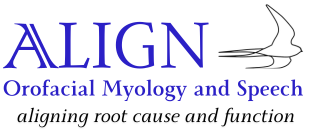Orofacial Myofunctional Disorders

Orofacial Myofunctional Disorders (OMDs) The presence of OMDs can affect children and adults and can have a significant impact on your health. Each muscle in the face and mouth has a specific job and when they are weak or not properly engaged in function, the surrounding muscles of your tongue, jaw, and lips must work harder to compensate. This can negatively affect teeth alignment, jaw development, and the size and shape of your palate impacting your airway and daily life. Early treatment for children can help prevent a lifetime of health challenges. OMDs in adults can be reduced, since they often become more troublesome with age.
Orofacial Myofunctional Therapy (OMT) can help address the root causes of OMDs which is key to helping you overcome your symptoms. Through a series of uniquely prescribed daily exercises, you can improve strength, posture, and coordination of your facial muscles to restore healthy oral function to breathe, sleep and live better!
Mouth Breathing
Mouth breathing is inflammatory to our bodies and can result in dentoskeletal growth changes, leading to a narrow palate, small jaw, dental crowding, crossbite, open bite and more that directly affect speech, chewing, swallowing, breathing, and sleeping. Our nasal passages act like humidifiers to warm and moisten the air entering our body, filtering out debris and defending our body against unfriendly microbes. The nose produces nitric oxide, which improves your lungs ability to absorb oxygen and transport it throughout the body. Nitric oxide can reduce inflammation, relax your blood vessels to increase blood flow to your body for cardiovascular, and other aspects of health. Mouth breathing is a pre-curser to sleep apnea and is associated with poor tongue posture.

Sleep Disordered Breathing
Lack of deep, restorative sleep negatively affects every cell, organ, system in the body, setting off a cascade of health issues in young people that were previously not prevalent till the senior years. Several studies also document ADHD symptoms and learning difficulties resulting from and causing sleep disturbances. Orofacial myofunctional therapy has been found to decrease apnea-hypopnea index (AHI) by 60% in children and 50% in adults, decrease snoring intensity and overall daytime sleepiness, and increase the lowest oxygen saturation level for mild to moderate sleep apnea.
Typically, removal of tonsils/adenoids alone improves breathing and sleep only temporarily in most (average of 6 months to 1 year), since changes in structural development of the mouth and airway have already occurred. Orofacial myofunctional exercises target the tongue and throat muscles for increasing tone, endurance, and coordination for correct function. The muscles that are used for correct swallowing also dilate the airway for sleep.
Tongue Posture and the ideal resting place
The ideal resting place for your tongue should be completely up on the palate with tongue tip just behind the top front teeth. If lips are open or the tongue is down or resting against teeth during passive activities like silent reading, watching TV, playing video games, driving, walking, doing homework, or sleeping, the mouth is not in correct rest posture. Why is tongue posture important? A displaced tongue has to make compensatory movements to function. It has to recruit other muscles from your lips, jaws, cheeks, and neck to speak, breathe, chew, swallow, and sleep. Correct rest posture is your tongue’s “home base” for achieving correct speaking. If your tongue is resting low in the mouth it will obstruct your airway, leading to snoring, teeth grinding/clenching, and sleep apnea/other breathing disordered sleep issues.
Tongue Tie
The frenum is a band of tissue under your tongue. It is considered “tied” if it is too short, thick, tight, or attached too far forward or with extra tissue on the bottom of your mouth. This restriction impacts the ability of the tongue to move, reach, and make shapes needed for correct speech, swallowing, and breathing leading to symptoms such as chewing or swallowing problems, speech errors, snoring, grinding or clenching of the teeth, sleep apnea, jaw pain/popping, digestive issues, neck/shoulder pain, and more! A thorough orofacial myofunctional evaluation can determine if a tongue tie exists and whether or not it affects function to the degree that a release may be needed. A trained orofacial myofunctional therapist can help reshape muscle patterns and strength to correct function affected by a tie or, in the case of needing a tie release, provide the necessary preparation regimen and post-release neuromuscular training to maximize functional outcome of the release, often called a frenectomy/frenuloplasty.
Tongue Thrust Swallow
A tongue thrust swallow occurs when the tongue moves forward, usually against or between teeth, and sometimes the tongue even slips visibly through the lips. This occurs because the muscles learned to swallow incorrectly as a result of compensating for a small mouth/narrow palate, incorrect tongue resting posture, mouth breathing, tongue tie, misaligned teeth, and effects from prolonged thumb sucking or pacifier use. The tongue should be up in the palate and moving back to provide a healthy, efficient, and safe swallow, support proper development of the palate, jaw, and dentition, support the results achieved from orthodontic work, and keep the muscles that dilate the airway for breathing and sleep toned and effective. A tongue thrust can also occur during speech, with the typical result being a lisp on production of “s, z, sh, ch”.
Speech Problems that may develop from an OMD
Speech errors can result from abnormal muscle patterns and/or oral structural differences in the mouth like a narrow palate, enlarged tonsils, tongue or lip tie, low resting or forward tongue posture, open bite/misaligned teeth, or changes in mouth shape from long-term pacifier use or thumb sucking, to name a few! Common problems seen with orofacial myofunctional disorders are errors on “s, z, l, r, ch, sh, j”, a lisp, lack of progress or resistance to continued progress in speech therapy, hoarse voice, or nasal voice.
Myofunctional Therapy Program
Standard treatment plans will be based on your individual needs and will vary in time and length. Your initial orofacial myofunctional evaluation will help us uncover your specific strengths and needs
Every person is unique, and the objective of the OMT program is to help you achieve: tongue posture, nasal breathing, and proper swallowing pattern, day/night nasal breathing with correct lip and tongue resting posture, proper chewing, and a correct, healthy (non-thrusting) swallowing pattern, all of which can improve speech, breathing, sleep, and overall health! We help you make positive changes through a series of simple daily exercises that can be easily incorporated into your daily routine. Standard treatment plans will be based on your individual needs and will vary in time and length. We are committed to helping you achieve the best possible outcome and often typically collaborate with other healthcare or dental providers. We are passionate about helping you achieve long-term results through OMT to greatly improve your health!
Benefits
Myofunctional therapy is a benefit to patients of all ages. Oral and facial muscle dysfunction, disordered breathing, noxious oral habits, tongue/lip ties, and other functional deficits may appear as obvious everyday hurdles like thumb-sucking, speech, or feeding issues or more subtly as often-overlooked symptoms like head, neck/ shoulder pain, poor sleep quality and inappropriate levels of energy, clarity, and focus.
Myofunctional therapy offers a holistic approach to wellness and encourages lifelong health through improved posture, better breathing, and proper oral function. Therapy is individualized! There is no cookie cutter program or ready-made treatment plan. Your personal health goals combined with my education and experience will determine your treatment plan, and I am privileged to be a part of your health care team!
